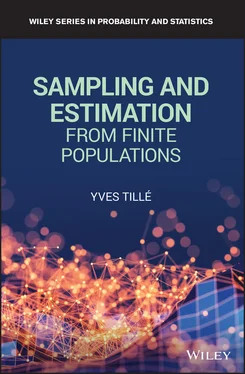All rights reserved. No part of this publication may be reproduced, stored in a retrieval system, or transmitted, in any form or by any means, electronic, mechanical, photocopying, recording or otherwise, except as permitted by law. Advice on how to obtain permission to reuse material from this title is available at http://www.wiley.com/go/permissions.
The right of Yves Tillé to be identified as the author of this work has been asserted in accordance with law.
Registered Offices
John Wiley & Sons, Inc., 111 River Street, Hoboken, NJ 07030, USA
John Wiley & Sons Ltd, The Atrium, Southern Gate, Chichester, West Sussex, PO19 8SQ, UK
Editorial Office
9600 Garsington Road, Oxford, OX4 2DQ, UK
For details of our global editorial offices, customer services, and more information about Wiley products visit us at www.wiley.com.
Wiley also publishes its books in a variety of electronic formats and by print‐on‐demand. Some content that appears in standard print versions of this book may not be available in other formats.
Limit of Liability/Disclaimer of Warranty
While the publisher and authors have used their best efforts in preparing this work, they make no representations or warranties with respect to the accuracy or completeness of the contents of this work and specifically disclaim all warranties, including without limitation any implied warranties of merchantability or fitness for a particular purpose. No warranty may be created or extended by sales representatives, written sales materials or promotional statements for this work. The fact that an organization, website, or product is referred to in this work as a citation and/or potential source of further information does not mean that the publisher and authors endorse the information or services the organization, website, or product may provide or recommendations it may make. This work is sold with the understanding that the publisher is not engaged in rendering professional services. The advice and strategies contained herein may not be suitable for your situation. You should consult with a specialist where appropriate. Further, readers should be aware that websites listed in this work may have changed or disappeared between when this work was written and when it is read. Neither the publisher nor authors shall be liable for any loss of profit or any other commercial damages, including but not limited to special, incidental, consequential, or other damages.
Library of Congress Cataloging‐in‐Publication Data
Names: Tillé, Yves, author. | Hekimi, Ilya, translator.
Title: Sampling and estimation from finite populations / Yves Tillé ; most
of this book has been translated from French by Ilya Hekimi.
Other titles: Théorie des sondages. English
Description: Hoboken, NJ : Wiley, [2020] | Series: Wiley series in
probability and statistics applied. Probability and statistics section |
Translation of: Théorie des sondages : échantillonnage et estimation
en populations finies. | Includes bibliographical references and index.
Identifiers: LCCN 2019048451 | ISBN 9780470682050 (hardback) | ISBN
9781119071266 (adobe pdf) | ISBN 9781119071273 (epub)
Subjects: LCSH: Sampling (Statistics) | Public opinion polls – Statistical
methods. | Estimation theory.
Classification: LCC QA276.6 .T62813 2020 | DDC 519.5/2 – dc23
LC record available at https://lccn.loc.gov/2019048451
Cover Design: Wiley
Cover Image: © gremlin/Getty Images
The first version of this book was published in 2001, the year I left the Ecole Nationale de la Statistique et de l'Analyse de l'Information (ENSAI) in Rennes (France) to teach at the University of Neuchâtel in Switzerland. This version came from several course materials of sampling theory that I had taught in Rennes. At the ENSAI, the collaboration with Jean‐Claude Deville was particularly stimulating.
The editing of this new edition was laborious and was done in fits and starts. I thank all those who reviewed the drafts and provided me with their comments. Special thanks to Monique Graf for her meticulous re‐reading of some chapters.
The almost 20 years I spent in Neuchâtel were dotted with multiple adventures. I am particularly grateful to Philippe Eichenberger and Jean‐Pierre Renfer, who successively headed the Statistical Methods Section of the Federal Statistical Office. Their trust and professionalism helped to establish a fruitful exchange between the Institute of Statistics of the University of Neuchâtel and the Swiss Federal Statistical Office.
I am also very grateful to the PhD students that I have had the pleasure of mentoring so far. Each thesis is an adventure that teaches both supervisor and doctoral student. Thank you to Alina Matei, Lionel Quality, Desislava Nedyalkova, Erika Antal, Matti Langel, Toky Randrianasolo, Eric Graf, Caren Hasler, Matthieu Wilhelm, Mihaela Guinand‐Anastasiade, and Audrey‐Anne Vallée who trusted me and whom I had the pleasure to supervise for a few years.
Yves Tillé
Neuchâtel, 2018
Preface to the First French Edition
This book contains teaching material that I started to develop in 1994. All chapters have indeed served as a support for teaching, a course, training, a workshop or a seminar. By grouping this material, I hope to present a coherent and modern set of results on the sampling, estimation, and treatment of nonresponses, in other words, on all the statistical operations of a standard sample survey.
In producing this book, my goal is not to provide a comprehensive overview of survey sampling theory, but rather to show that sampling theory is a living discipline, with a very broad scope. If, in several chapters demonstrations have been discarded, I have always been careful to refer the reader to bibliographical references. The abundance of very recent publications attests to the fertility of the 1990s in this area. All the developments presented in this book are based on the so‐called “design‐based” approach. In theory, there is another point of view based on population modeling. I intentionally left this approach aside, not out of disinterest, but to propose an approach that I deem consistent and ethically acceptable to the public statistician.
I would like to thank all the people who, in one way or another, helped me to make this book: Laurence Broze, who entrusted me with my first sampling course at the University Lille 3, Carl Särndal, who encouraged me on several occasions, and Yves Berger, with whom I shared an office at the Université Libre de Bruxelles for several years and who gave me a multitude of relevent remarks. My thanks also go to Antonio Canedo who taught me to use LaTeX, to Lydia Zaïd who has corrected the manuscript several times, and to Jean Dumais for his many constructive comments.
I wrote most of this book at the École Nationale de la Statistique et de l'Analyse de l'Information . The warm atmosphere that prevailed in the statistics department gave me a lot of support. I especially thank my colleagues Fabienne Gaude, Camelia Goga, and Sylvie Rousseau, who meticulously reread the manuscript, and Germaine Razé, who did the work of reproduction of the proofs. Several exercises are due to Pascal Ardilly, Jean‐Claude Deville, and Laurent Wilms. I want to thank them for allowing me to reproduce them. My gratitude goes particularly to Jean‐Claude Deville for our fruitful collaboration within the Laboratory of Survey Statistics of the Center for Research in Economics and Statistics. The chapters on the splitting method and balanced sampling also reflect the research that we have done together.
Yves Tillé
Bruz, 2001
Chapter 1 A History of Ideas in Survey Sampling Theory
Читать дальше












